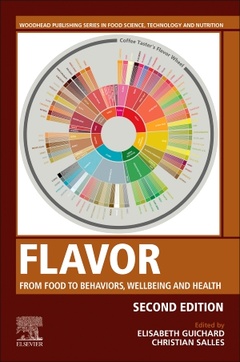Flavor (2nd Ed.) From Food to Behaviors, Wellbeing and Health

Flavor: From Food to Behaviors, Wellbeing and Health, Second Edition presents the different mechanisms of flavor perception.
Broken into four parts, the first begins with coverage of flavor release in humans. Part two addresses flavor perception, from molecules to receptors and brain integration. Part three analyzes flavor perception, preferences and food intake. Finally, part four considers flavor perception and physiological status.
Academics working in the areas of sensory science, food quality, nutrition and human sciences, as well as research and development professionals and nutritionists, will benefit from this important revised reference.
Part one: Flavor release in Humans 1. Modulation of flavour release and perception by food matrix composition and structure 2. Dynamic methods to link flavor release and flavor perception 3. How amniotic fluid shapes early odor-guided responses to colostrum and milk (and more) 4. In-mouth metabolism of flavour compounds
Part two: Flavor perception, from molecule to receptor and brain integration 5. Taste perception and integration 6. Olfactory function of nasal odorant metabolism 7. Olfactory perception and integration 8. Multimodal integration 9. Brain processing 10. Holistic perception and memorization of flavor
Part three: Flavor perception, preferences and food intake 11. Learning of human flavor preferences 12. Relationships between early flavor/texture exposure, and food acceptability and neophobia 13. Flavor perception and satiation 14. Familiarity, monotony, or variety: The role of flavour complexity in food intake
Part four: Flavor perception and physiological status 15. Metabolic status and olfactory function 16. Taste disorders in disease including COVID 17. Olfactory disorders and consequences 18. Relationship between oral microbiota and flavour perception
Christian Salles is research director at INRAE. His main research field carries on in-mouth mechanisms leading to flavour release and perception with in vivo and in vitro approaches. He coordinated the development of chewing simulators dedicated to in vitro approaches of temporal flavour release and food breakdown studies in controlled eating conditions. He has coordinated several projects related to the reduction of salt content in food and in particular a European project (TeRiFiQ – from 1/2012 to 12/2015) on the reduction of salt, fat and sugar in food, with 17 European partners including 11 SMEs. These last years, he focused his research on the temporal release of sodium according to food matrix composition and oral condition. He is the author of 80 publications in peer-reviewed journals, 117 communications in scientific congresses (oral and poster) and the author of 53 book chapters. He is the editor of 2 books.
- Addresses the link between flavor perception and human behaviors, specifically human physiology in relation to perception
- Presents opportunities for the reformulation of healthy foods while maintaining the acceptability by consumers
- Explains how flavor compounds may modulate food intake and behavior
- Assesses the influence of age, physiological disorders, or social environments on the impact of food flavor
Date de parution : 09-2022
Ouvrage de 502 p.
15.2x22.8 cm
Thème de Flavor :
Mots-clés :
Amniotic fluid; Aroma compound; Aroma; Arousal motivation theory; Artificial mouth; Attention; Baby-led weaning; Binding; Bitter; Breastfeeding; Cancer; Chemoreceptors; Children; Colostrum; Complementary feeding; Configural; Consumer insight; COVID-19Gustation; Craving; Cross-modal compensation; Eating behavior; Eating rate; Energy intake; Exposure; Expression; Fermented food; Fetus; Flavor release; Flavor; Food acceptance; Food boredom; Food choice; Food matrix; Food preference learning; Food preferences; Food texture; Formula; Gustation; Health; Hormones; Implicit real-world methodology; Implicit; Infant; Keyswords; Lactation; Learning; Malnutrition; Market introduction strategy; Maternal trajectory; Mechanistic model; Memory; Metabolic syndrome; Metabolization; Milk; Multisensory; Neonate; Neophobia; Neurological diseases; Neuropeptides; Obesity; Odor coding; Odor discrimination; Odor sensitivity; Odor; Odorant metabolite; Odorant-metabolizing enzymes; Olfaction; Olfactory bulb; Olfactory cortex; Olfactory epithelium; Olfactory mucosa; Olfactory plasticity; Olfactory receptor; Olfactory sensory neuron; Oral metabolism; Oral microbiota; Oral physiology; Perceived flavor complexity; Perceptual integration; Perireceptor events; Plasticity; Postnatal; Prenatal; Quality coding; Saliva; Salty; Sensory cues; Sensory programming; Solid foods; Sour; Sweet; Tastant; Taste compound; Taste perception; Taste receptor; Taste; Taste-taste interaction; Texture; Transnatal chemosensory continuity; Trigeminal perception; Trigeminal sensations; Umami; Unitary; Uterine



